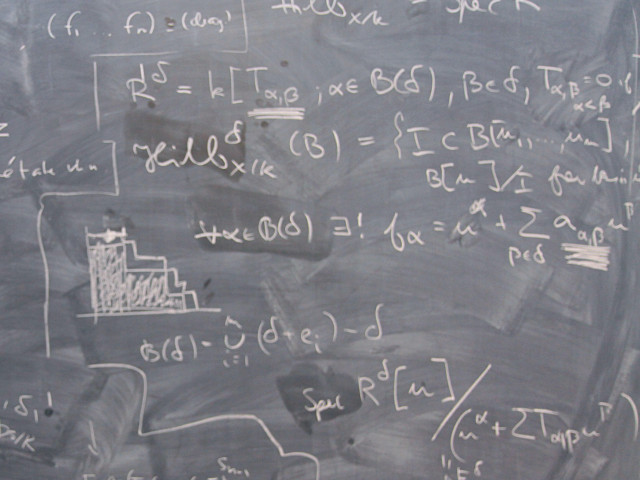SF1906 Matematisk statistik, grundkurs 9,0 hp
Denna kurs är avvecklad.
Sista planerade examination: VT 2013
Avvecklingsbeslut:
Ingen information tillagd
Innehåll och lärandemål
Kursinnehåll
Grundläggande begrepp såsom sannolikhet, betingad sannolikhet och oberoende händelser. Diskreta och kontinuerliga stokastiska variabler, i synnerhet endimensionella stokastiska variabler. Läges-, spridnings- och beroendemått för stokastiska variabler och datamängder. Vanliga fördelningar och deras modellsituationer, bland annat normalfördelningen, binomialfördelningen och poissonfördelningen. Centrala gränsvärdessatsen och stora talens lag.
Beskrivande statistik.
Punktskattningar och generella skattningsmetoder såsom Maximum-likelihoodmetoden och Minsta-kvadratmetoden. Allmänna konfidensintervall men speciellt konfidensintervall för väntevärde och varians i normalfördelning. Konfidensintervall för andelar och skillnad i väntevärden och andelar.
Hypotesprövning. Chi2-test av fördelning, homogenitetstest och kontigenstabeller. Linjär regression.
Markovprocesser med diskreta tillståndsrum. Absorption, stationaritet och ergodicitet. Födelse- dödsprocesser i allmänhet och Poissonprocessen i synnerhet. Enkla modeller för betjäningssystem, M/M/1 och M/M/c, och köteori.
Lärandemål
Efter fullgjord kurs förväntas studenten kunna
- konstruera elementära statistiska modeller för experiment
- beskriva standardmodeller och redogöra för tillämpbarheten för dessa i givna exempel
- definiera och beräkna sammanfattande beskrivande storheter för statistiska fördelningar och datamängder såsom läges-, spridnings- och beroendemått
- med standardmetoder såsom Maximum-likelihhodmetoden och minsta-kvadratmetoden utveckla skattningar för storheter och kvantifiera osäkerheten i dessa skattningar, till exempel med felfortplantningsformler och konfidensintervall
- värdera och jämföra skattningar bland annat med hänsyn till egenskaper såsom väntevärdesriktighet och effektivitet
- analysera hur mätosäkerhet påverkar slutsatser och kvantifiera risker och felsannolikheter i statistiska modeller vid hypotesprövning
- ställa upp enkla markovkedjemodeller i diskret och kontinuerlig tid och redogöra för deras asymptotiska uppträdande och egenskaper, speciellt Poissonprocessens
- använda absorptionsteknik i kontinuerlig och diskret tid för Markovkedjor
- modellera enkla kösystem med födelse- dödsprocesser och göra beräkningar i dessa modeller av köteoretiskt intressanta storheter såsom förväntad kölängd och kötid etc.
För att uppnå högsta betyg förväntas studenten dessutom kunna följande:
- Kombinera samtliga ovannämnda begrepp och metoder för att lösa mer sammansatta problem.
Kurslitteratur och förberedelser
Särskild behörighet
Differential- och integralkalkyl. Grundläggande linjär algebra.
Rekommenderade förkunskaper
Utrustning
Kurslitteratur
Blom m.fl.: Sannolikhetslära och statistikteori med tillämpningar. Studentlitteratur.
Enger, Grandell. Markovprocesser och köteori, Kompendium.
Kursmaterial från institutionen för matematik.
Examination och slutförande
När kurs inte längre ges har student möjlighet att examineras under ytterligare två läsår.
Betygsskala
Examination
- TEN1 - Skriftlig tentamen, 6,0 hp, betygsskala: A, B, C, D, E, FX, F
- ÖVN1 - Inlämningsuppgifter, 3,0 hp, betygsskala: P, F
Examinator beslutar, baserat på rekommendation från KTH:s handläggare av stöd till studenter med funktionsnedsättning, om eventuell anpassad examination för studenter med dokumenterad, varaktig funktionsnedsättning.
Examinator får medge annan examinationsform vid omexamination av enstaka studenter.
Övriga krav för slutbetyg
En skriftlig tentamen (TENA;9 hp).
Möjlighet till komplettering
Möjlighet till plussning
Examinator
Etiskt förhållningssätt
- Vid grupparbete har alla i gruppen ansvar för gruppens arbete.
- Vid examination ska varje student ärligt redovisa hjälp som erhållits och källor som använts.
- Vid muntlig examination ska varje student kunna redogöra för hela uppgiften och hela lösningen.